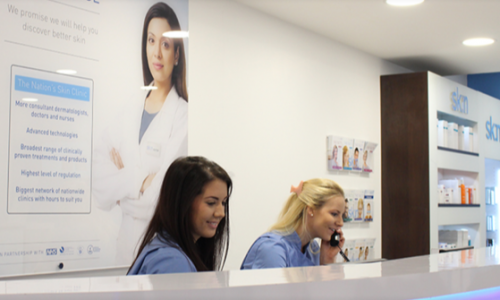Will Mole Removal Scar Me?

Medically Reviewed June 2023, by Daron Seukeran, Group Medical Director, for sk:n. Next review due June 2024.
A mole is a small brown or black patch on the skin, similar to a freckle. Most people have moles, and they’re usually not a problem. Generally, they are round or oval-shaped with a smooth edge; moles can be flat or raised and smooth or rough. Sometimes moles have hair(s) growing from them.
Melanocytes, which create the colour or pigment in your skin, form clusters of skin cells that cause moles. The average person has 10 to 40 moles on their body, but if one of them changes, it could be malignant. .
Spotting a malignant mole early can save your life. There is a 99%, 5-year survival rate for patients whose melanoma is detected early. This drops to 66% if cancer has reached the lymph nodes, 27% if it has already spread to distant organs.
Read on to discover more about mole removal and if it will leave a scar.
Can You Remove Moles Without Scarring?
The amount of scarring you get from a mole removal will depend on the process you have undertaken to remove that mole. There are three main ways to remove moles professionally. These are:
- Laser Mole Removal
If your mole is small, laser treatment can be used to eliminate it. Laser mole removal uses light energy to break down the pigment within the mole. Bursts of laser radiation are aimed at the mole during the treatment, breaking down the skin cells that make it up.
The mole will vanish immediately following your surgery, leaving only a faint red mark where it was previously. The region will heal in the same way that a graze would, taking 10 to 14 days to develop a smooth, pinkish mark that will vanish after a few weeks.
Because there is minimal chance of scarring, this procedure is a suitable choice for removing a mole off the face.
- Shave Mole Removal
Under local anaesthetic (this numbs the treated area), moles that protrude from the skin can be ‘shaved’ away. This is typically done with a scalpel and is a reasonably painless and straightforward procedure.
This simple operation is far less invasive than a full-thickness skin excision because it doesn’t require sutures or stitches. Once the mole is removed, it will be sent to a laboratory to be looked at in detail in order to check for any abnormalities or cancers.
Your doctor will instruct you about keeping the area of skin dry for 24 hours and when to change or remove the bandage. There may be a pink mark on your skin where the mole used to be, but this will diminish with time.
- Mole Excision
Some moles, especially those that are bigger, may require excision. This operation is done with a local anaesthetic and ends with a tiny stitch in the skin.
During the procedure the entire mole and a tiny portion of the surrounding skin will be removed, and the mole will be taken away to be examined by specialists in a laboratory.
A small number of stitches may be required to close the wound, and the region will be bandaged in a sterile bandage. There will be a little scar that will diminish over time.
Sk:n clinics offer all of these treatments to remove moles.
The best way to remove moles without scarring? Probably the laser removal treatment, though this won’t be the right choice for potentially cancerous moles.
Removing A Mole Yourself
When you cut a mole off yourself, you risk leaving a visible, permanent scar where the mole used to be, increasing your risk of infection tenfold, especially if you don’t use a sanitised tool.
You won’t be able to tell if the mole is cancerous if you remove it yourself. You risk getting melanoma, which can spread throughout your body and cause life-threatening cancer; if you don’t have a doctor or dermatologist, test the mole that has been removed.
How To Prevent Mole Removal Scarring
Whether it’s from an intensive surgery or a simple scrap, all wounds to the skin can leave a scar because this is your body’s natural way of healing a wound. However, there are some steps you can take to reduce scarring to your body after your mole removal treatment.
- Avoid the sun
A fresh wound is more likely to darken and become discoloured if exposed regularly to sun (UV) light. If you’re going to be spending time outside, always cover your scar with strong sun cream and, where possible, wear sun-protective clothing.
- Keep the area moist
Skin wounds heal better when they’re moist, whereas dry wounds take longer to heal and are more likely to fade. An antibiotic ointment under the bandage will help to reduce scar formation when your wound is still healing.
- Massage the scar
After your sutures are gone, and your scabs have disappeared, you can start to massage the scar. Never pull the scab off before it is ready; this will worsen scarring. Use two fingers to rub circles on the scar and the skin around it, starting with light pressure. This will ensure a healthy supply of collagen is healing the skin.
- Don’t stretch the scar
A lot of movement and stretching of the skin could lead to a longer healing time and, in turn, a bigger scar. Take care as much as possible with your scar and the skin around it to ensure there’s less pulling in your wound.
Key Takeaways
- A mole is a small brown or black patch on the skin, similar to a freckle. Most people have moles, and they’re usually not a problem unless they change shape, size, or colour.
- Your mole can be removed in a few ways, including laser removal, shave removal, and excision removal; the least scarring procedure is probably laser removal.
- Taking care of your wound after your procedure can help you reduce the chance of scarring; this involves keeping the area moist, out of the sun, and treating it gently.
Find your nearest clinic and arrange a consultation with one of our dermatologists for advice on how and when to remove your mole(s).
Related Articles

08
Apr 2024

08
Apr 2024
Request a callback
One of our friendly sk:n advisors will call you to book your consultation.
- More than 450 consultants, doctors, nurses and medical practitioners
- Regulated by the Care Quality Commission, Health Inspectorate Wales and Health Improvement Scotland
- Partner of the NHS
- Rated excellent by our clients on Trustpilot
- Strict safety and care protocols




